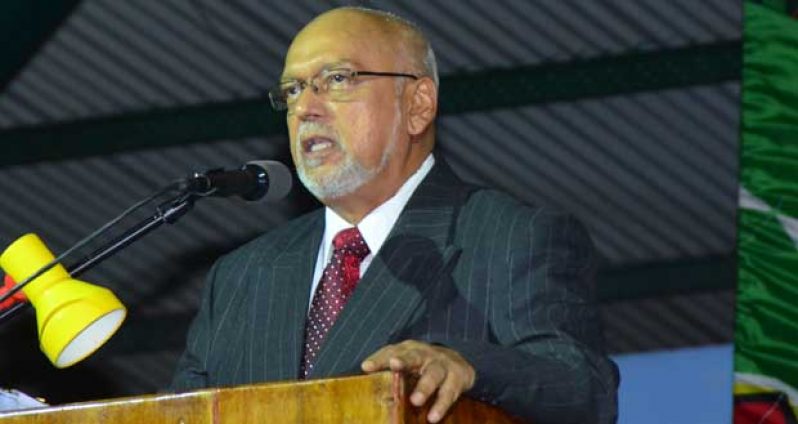THE Guyana Government’s much lauded decision earlier this week to significantly reduce fuel prices on the local market, amid falling fuel prices globally, has resulted in appreciable benefits to consumers.
And the possibility of the reduced fuel prices also impacting on the sums paid by electricity consumers to the Guyana Power and Light Inc. (GPL) is one that is currently under serious consideration.
In fact, President Donald Ramotar, in an invited comment to this newspaper last evening, disclosed that he has asked GPL to examine the possibility of reducing electricity rates to customers.
The President told the Chronicle that GPL has promised to explore all the options, in light of the reduction of fuel prices, whereby electricity consumers can benefit from lower electricity rates.
Finance Minister Dr. Ashni Singh, on Tuesday, announced significant reductions in local fuel prices as follows: gas price was reduced from $995 per gallon to $695, representing a 30 per cent reduction; diesel price was reduced by 30 per cent, from $985 to $694; and kerosene saw a reduction of 42 per cent, from $850 to $496.
Consequently, there have been queries as to whether the electricity costs borne by customers will also benefit from the falling fuel prices.
Currently, GPL benefits from significant subsidies provided by the Government and Government’s intervention has helped to stay the cost of electricity even at the times when fuel prices were high – meaning that the actual cost of electricity was not passed on to the customers, given that Government covered a significant portion of the high prices through subsidies to GPL.
For the last three years, the combined Opposition has slashed the subsidies to GPL, which were subsequently restored by Government, to ensure that the consumers did not have to suffer increased electricity costs.
GOVERNMENT SUPPORT
In 2014, Government allocated some $8B to GPL – a move that has been made for several years now and the current Administration, last year, announced a 50 per cent increase in electricity subsidy to pensioners.
To date, some 10,000 pensioners are benefiting from this intervention. The subsidy to pensioners meant that some $30,000 was waived from their annual GPL bills, once they are GPL customers.
Figures released by the Ministry of Human Services and Social Security detail that those benefiting include pensioners from Regions Two (Pomeroon/Supenaam), Three (West Demerara/ Essequibo Islands), Four (Demerara/Mahaica), Five (Mahaica/Berbice), Six (East Berbice/ Corentyne) and Seven (Cuyuni/Mazaruni).
In total, $300M have been allocated in the National Budget for this programme.
The year 2013 saw pensioners receiving an annual contribution of $20,000, once they are customers of the Guyana Power and Light Company (GPL). Last year, the value of this electricity assistance programme has been increased to $30,000 per annum for each eligible beneficiary.
Over the years, a large portion of the budget has been going towards the social sector with the aim of improving the quality of life for Guyanese of all ages.
PREREQUISITE FOR AMAILA
Meanwhile, Guyana now boasts a modern integrated electricity grid, linking Berbice and Demerara, since the final component of the new system, the Guyana Power and Light’s Georgetown sub-station, Ruimveldt, was commissioned last December.
Completed under GPL’s US$38.9M Infrastructure Development Programme (IDP), the new system is expected to facilitate and upgrade voltage stability and efficient electricity distribution. The IPD was funded by the Government of Guyana and in part by a concessional loan from the Export-Import Bank of China.
However, Chairman of GPL’s Board of Directors, Winston Brassington, underscored the fact that the integrated electricity grid was not only done to meet international standards – in the interest of mitigating several challenges, including cost of electricity to Guyanese – but is also a pre-requisite for the Amaila Falls Hydro Project (AFHP), which is a project that is considered important by GPL.
The hydropower project is touted to be able to provide Guyanese with a cheaper, reliable and sustainable electricity supply. It involves the construction of a hydropower plant in the area of West-Central Guyana, where the Amaila and Kuribrong Rivers meet. Electricity produced there would be delivered to Georgetown and Guyana’s second largest town, Linden.
The AFHP is anticipated to result in substantial savings to the nation’s coffers, particularly in terms of foreign exchange and the purchase of heavy fuel oil.
President Donald Ramotar’s consistent position on developing hydropower is that economies must serve the people, not vice-versa, and with an expected saving of $9B in electricity subsidies, as well as savings on the $40B fuel bill, enormous contributions can be made to the infrastructural development, which is particularly needed in Guyana’s hinterland to aid and accelerate economic progress.
Mr. Ramotar has also stressed that, despite the disposition of the combined Opposition, the project is not dead. “We are very close to taking a decision on what direction to go to put Amaila back on stream,” the President has said.
Additionally, the potential benefits of a more stable and reliable source of energy through the advancement of hydroelectricity was also targeted by the International Monetary Fund (IMF), last December, as an area for continued focus.
Guyana spent some $23B in fuel last year alone to ensure the provision of electricity to Guyanese.



.jpg)








